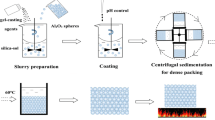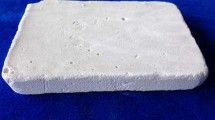Abstract
Using phase separation, alumina-based porous ceramics with three-dimensional frameworks were prepared, with fine structural roughness created by subsequent hot-water treatment. The pore volume of the porous alumina and its specific surface area increased concomitantly with increasing hot-water treatment time. Porous alumina/fluorinated oil bulk composites were prepared by coating hydrophobic silane onto the porous ceramic surface and subsequently impregnating fluorinated oil. A wetting ridge formed at the bottom of the water droplets on the composites. Partial contact between the water and solid surface was inferred from a comparison of interface energies in the system. The composites provided a smaller sliding angle (SA) than that of the sample without impregnating fluorinated oil. The composite with fine roughness exhibited longer sustainability of a small SA than that without fine roughness. Particle image velocimetry revealed that the dominant sliding mode for water droplets on this composite was slipping. The droplets moved on the surface under an external electric field. Coulombic force contributes to this motion.











Similar content being viewed by others
References
A. Nakajima: Design of hydrophobic surfaces for liquid droplet control. NPG Asia Mater. 3, 49–56 (2011).
R.N. Wenzel: Resistance of solid surfaces to wetting by water. Ind. Eng. Chem. 28, 988–994 (1936).
A.B.D. Cassie and S. Baxter: Wettablity of porous surfaces. Trans. Faraday Soc. 40, 546–551 (1944).
A. Nakajima, K. Hashimoto, and T. Watanabe: Recent studies on super-hydrophobic films. Monatsh. Chem. 132, 31–41 (2001).
X. Feng and L. Jiang: Design and creation of superwetting/antiwetting surfaces. Adv. Mater. 18, 3063–3078 (2006).
R. Blossey: Self-cleaning surfaces—virtual realities. Nat. Mater. 2, 301–306 (2003).
M. Miwa, A. Nakajima, A. Fujishima, K. Hashimoto, and T. Watanabe: Effects of the surface roughness on sliding angles of water droplets on super-hydrophobic surfaces. Langmuir 16, 5754–5760 (2000).
G. McHale, N.J. Shirtcliffe, and M.I. Newton: Contact-angle hysteresis on super-hydrophobic surfaces. Langmuir 20, 10146–10149 (2004).
T.P. Nguyen, P. Brunet, Y. Coffinier, and R. Boukherroub: Quantitative testing of robustness on superomniphobic surfaces by drop impact. Langmuir 26, 18369–18373 (2010).
L. Bocquet and E. Lauga: A smooth future?Nat. Mater. 10, 334–337 (2011).
T-S. Wong, S.H. Kang, S.K.Y. Tang, E.J. Smythe, B.D. Hatton, A. Grinthal, and J. Aizenberg: Bioinspired self-repairing slippery surfaces with pressure-stable omniphobicity. Nature 477, 443–447 (2011).
L. Courbin, E. Denieul, E. Dressaire, M. Roper, A. Ajdari, and H.A. Stone: Imbibition by polygonal spreading on microdecorated surfaces. Nat. Mater. 6, 661–664 (2007).
U. Bauer and W. Federle: The insect-trapping rim of Nepenthes pitchers: Surface structure and function. Plant Signal. Behav. 4, 1019–1023 (2009).
A. Lafuma and D. Quéré: Slippery pre-suffused surfaces. Europhysics Lett. 96, 56001 (2011).
W. Ma, Y. Higaki, H. Otsuka, and A. Takahara: Perfluoropolyether-infused nano-texture: A versatile approach to omniphobic coatings with low hysteresis and high transparency. Chem. Commun. 49, 597–599 (2013).
H.A. Stone: Ice-phobic surfaces that are wet. ACS Nano 6, 6536–6540 (2012).
P. Kim, T-S. Wong, J. Alvarenga, M.J. Kreder, W.E. Adorno-Martinez, and J. Aizenberg: Liquid-infused nanostructured surfaces with extreme anti-ice and anti-frost performance. ACS Nano 6, 6569–6577 (2012).
K. Rykaczewski, S. Anand, S.B. Subramanyam, and K.K. Varanasi: Mechanism of frost formation on lubricant-impregnated surfaces. Langmuir 29, 5230–5238 (2013).
S. Anand, A.T. Paxson, R. Dhiman, J.D. Smith, and K.K. Varanasi: Enhanced condensation on lubricant-impregnated nanotextured surfaces. ACS Nano 6, 10122–10129 (2012).
J.D. Smith, R. Dhiman, S. Anand, E. Reza-Garduno, R.E. Cohen, G.H. McKinleya, and K.K. Varanasi: Droplet mobility on lubricant-impregnated surfaces. Soft Matter 9, 1772–1780 (2013).
N. Vogel, R.A. Belisle, B. Hatton, T-S. Wong, and J. Aizenberg: Transparency and damage tolerance of patternable omniphobic lubricated surfaces based on inverse colloidal monolayers. Nat. Commun. 4, 2167 (2013).
X. Yao, Y. Hu, A. Grinthal, T-S. Wong, L. Mahadevan, and J. Aizenberg: Adaptive fluid-infused porous films with tunable transparency and wettability. Nat. Mater. 12, 529–534 (2013).
S. Gogte, P. Vorobieff, R. Truesdell, A. Mammoli, F. van Swol, P. Shah, and C.J. Brinker: Effective slip on textured superhydrophobic surfaces. Phys. Fluids 17, 51701 (2005).
S.R. Hodges, O.E. Jensen, and J.M. Rallison: Sliding, slipping and rolling: The sedimentation of a viscous drop down a gently inclined plane. J. Fluid Mech. 512, 95–131 (2004).
J.B. Brzoska, F. Brochard, and F. Rondelez: Motions of droplets on hydrophobic model surfaces induced by thermal gradients. Langmuir 9, 2220–2224 (1993).
K. Takeda, A. Nakajima, K. Hashimoto, and T. Watanabe: Control of water droplets on super-hydrophobic surfaces by static electric field. Jpn. J. Appl. Phys. 41, 287–291 (2002).
X. Hong, X. Gao, and L. Jiang: Application of superhydrophobic surface with high adhesive force in no lost transport of superparamagnetic microdroplet. J. Am. Chem. Soc. 129, 1478–1479 (2007).
K. Ichimura, S-K. Oh, and M. Nakagawa: Light-driven motion of liquids on a photoresponsive surface. Science 288, 1624–1626 (2000).
A. Hashimoto, M. Sakai, N. Yoshida, S. Suzuki, Y. Kameshima, and A. Nakajima: Direct measurement of the motion of water droplets on a hydrophobic self-assembled monolayer surface under airflow. J. Surf. Finishing Soc. Jpn. 59, 907–912 (2008).
Y. Tokudome, K. Fujita, and K. Nakanishi: Synthesis of monolithic Al2O3 with well-defined macropores and mesostructured skeletons via the sol–gel process accompanied by phase separation. Chem. Mater. 13, 3393–3398 (2007).
K. Tadanaga, N. Katata, and T. Minami: Formation process of super-water-repellent Al2O3 coating films with high transparency by the sol–gel method. J. Am. Ceram. Soc. 80, 3213–3216 (1997).
M. Sakai, A. Hashimoto, N. Yoshida, S. Suzuki, Y. Kameshima, and A. Nakajima: An image analysis system for evaluating sliding behavior of a liquid droplet on a hydrophobic surface. Rev. Sci. Instrum. 78, 045103 (2007).
S. Suzuki, A. Nakajima, M. Sakai, Y. Sakurada, N. Yoshida, A. Hashimoto, Y. Kameshima, and K. Okada: Slipping and rolling ratio of sliding acceleration for a water droplet sliding on fluoroalkylsilane coatings of different roughness. Chem. Lett. 37, 58–59 (2008).
W.C. Misra ed.: Oxides and Hydroxides of Alumina. Alcoa Technical Paper No. 19. (Alcoa Laboratories, 1987); p. 15.
T. Furuta, M. Sakai, T. Isobe, and A. Nakajima: Evaporation behavior of a microliter and sub-nanoliter scale water droplets on two different fluoroalkylsilane coatings. Langmuir 25, 11998–12001 (2009).
A. Nakajima, M. Hoshino, J-H. Song, Y. Kameshima, and K. Okada: Effect of roughness on lipophobicity of a surface prepared using boehmite nanoparticles and fluoroalkylsilane. Chem. Lett. 34, 908–909 (2005).
T. Furuta, M. Sakai, T. Isobe, S. Matsushita, and A. Nakajima: Sliding of water droplets on hydrophobic surfaces with various hydrophilic region sizes. Langmuir 27, 7307–7313 (2011).
D. Öner and T.J. McCarthy: Ultrahydrophobic surfaces. Effects of topography length scales on wettability. Langmuir 16, 7777–7782 (2000).
S.D. Iliev and N.C. Pesheva: Wetting properties of well-structured heterogeneous substrates. Langmuir 19, 9923–9931 (2003).
A. Nakajima, T. Miyamoto, M. Sakai, T. Isobe, and S. Matsushita: Comparative study of the impact and sliding behavior of water droplets on two different hydrophobic silane coatings. Appl. Surf. Sci. 292, 990–996 (2014).
M. Sakai, H. Kono, A. Nakajima, H. Sakai, M. Abe, and A. Fujishima: Water droplets’ internal fluidity during horizontal motion on a superhydrophobic surface with an external electric field. Langmuir 26, 1493–1495 (2010).
A.F. Diaz and R.M. Felix-Navarro: A semi-quantitative tribo-electric series for polymeric materials: The influence of chemical structure and properties. J. Electrostat. 62, 277–290 (2004).
K. Yatsuzaka, Y. Mizuno, and K. Asano: Electrification phenomena of distilled water dripping and sliding on polymer surface. J. Instrum. Electrostat. Jpn. 16, 401–410 (1992). [in Japanese].
ACKNOWLEDGMENTS
The authors are grateful to the staff of the Center of Advanced Materials Analysis (CAMA) at Tokyo Institute of Technology for SEM observations. This work was supported in part by a Grant-in-Aid for Scientific Research from the Ministry of Education, Culture, Sports, Science, and Technology of Japan.
Author information
Authors and Affiliations
Corresponding author
Additional information
Supplementary Material
To view supplementary material for this article, please visit http://dx.doi.org/jmr.2014.168.
Rights and permissions
About this article
Cite this article
Tsuruki, Y., Sakai, M., Isobe, T. et al. Static and dynamic hydrophobicity of alumina-based porous ceramics impregnated with fluorinated oil. Journal of Materials Research 29, 1546–1555 (2014). https://doi.org/10.1557/jmr.2014.168
Received:
Accepted:
Published:
Issue Date:
DOI: https://doi.org/10.1557/jmr.2014.168




